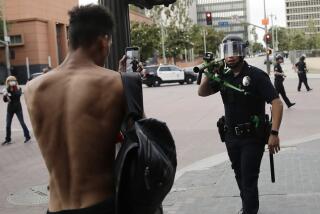New Year’s Eve Gunfire Declines Sharply : Holiday: Police report quietest celebration in two decades after campaign warning about danger of firing bullets into the air. Relatively few arrests are logged.
- Share via
Just before midnight on New Year’s Eve, the Taylor family spilled out into their front yard in South-Central Los Angeles to welcome in 1993.
It’s not something they have dared do in recent years. Gunfire--a deadly celebratory tradition in the city--has made the air too thick with bullets to safely venture outdoors.
But this year was different, Elizabeth Taylor said Friday as she removed Christmas lights from plastic candy-cane holders while her 2-year-old nephew rode his tricycle in the driveway. “I heard much less gunshots, and I didn’t hear the ambulances and police sirens going like crazy like last year.”
Taylor’s observations were on target, according to Los Angeles police, who reported the quietest New Year’s Eve in more than two decades.
There were no deaths from bullets fired into the air and relatively few arrests. The only reported injury was in Pacoima, where a bullet from one celebrant’s weapon came down and grazed Maria Salas’ forehead. Paramedics treated her at the scene.
Capt. Bruce Hagerty of the Los Angeles Police Department’s Southeast Division credited specially trained officers, and an intensive, citywide community education program with dramatically reducing the New Year’s Eve mayhem. A 1990 ordinance that bans ammunition sales in the city between Christmas and New Year’s also helped.
Which is not to say that New Year’s Eve 1992 was entirely peaceful.
Police dispatchers logged 788 calls about shooting incidents, and gunfire sounded sporadically after 10 p.m., becoming intense for about half an hour after midnight.
But this was an improvement over other New Year’s Eves when some Los Angeles residents began firing weapons at sundown and did not let up until dawn, police said.
The worst year on record was 1988. Two people were killed and dozens were injured by stray bullets.
“In 1988, you could go on any roof around here and find handfuls of bullets,” said Hagerty.
Added Southeast Division Capt.Willie L. Pannell: “It was so bad that I had people within 50 feet of me shooting Uzis (a military-type semiautomatic weapon) and there were so many of them you couldn’t do anything about it.”
Police arrested 37 people this New Year’s Eve, about half the number taken into custody the year before, Hagerty said. In 1989, the first year of a citywide crackdown on New Year’s Eve gunfire, 72 people were arrested during a long night of disturbances.
In fact, things were so quiet this time around that patrol commanders began sending officers home at 1 a.m. Friday, Hagerty said.
Among 62 weapons confiscated citywide were military assault rifles, sawed-off shotguns and the pistol-sized machine guns favored by Los Angeles street gangs. But others disarmed by police after firing into the air used antique guns and hunting rifles--evidence that the New Year’s Eve gunplay is not entirely the sport of criminals.
“The majority of people who shoot their weapons are law-abiding,” Hagerty said. The department’s community education campaign aimed to alert them to the dangers.
Beginning just after Christmas, police went door to door distributing 800,000 flyers, in English and Spanish, showing a handgun inside a circle with a slash across it--the international symbol for “no.” The flyer urged: “On New Year’s Eve, don’t endanger your loved ones.” It was a message repeated on posters, billboards, and bus benches throughout the city.
The officers were welcomed in their mission, especially in neighborhoods such as South-Central, where past New Year’s Eves have been blighted by fear of errant bullets.
Residents came out of their homes to help distribute the flyers, and generally expressed “overwhelming support,” Hagerty said.
South-Central resident Bobbie Smith was among the cheerleaders. She reported actually being able to sleep Thursday night, in contrast to previous years when wild bullets crashed through her bedroom window and pocked the family van.
“It was much, much quieter,” Smith told a reporter as she stood Friday morning outside the 99th Street home of her brother, Walter Dixon. Smith and her husband were visiting the Dixons to exchange New Year’s greetings. They compared their impressions of other New Year’s Eves.
Dixon recalled how early January rainstorms would be evidence of just how close bullets had come to his family, though they typically stayed indoors for safety.
“I would find new leaks in the roof,” Dixon said, caused by revelers’ bullets piercing the shingles.
A few blocks away on 107th Street, Elizabeth Taylor said she, too, could tell a difference.
But she also senses among her neighbors a new weariness with gun-related violence that may have restrained those who traditionally celebrated the new year’s arrival with firearms. Memories of the riots that brought tragedy and destruction to so many city neighborhoods last spring are still fresh, Taylor said, as she packed the Christmas lights away.
“The good people in my neighborhood never thought guns were cool, and it seems like even the bad people are tired of it now,” she said.
Times staff writer David Colker contributed to this report.
More to Read
Sign up for Essential California
The most important California stories and recommendations in your inbox every morning.
You may occasionally receive promotional content from the Los Angeles Times.










